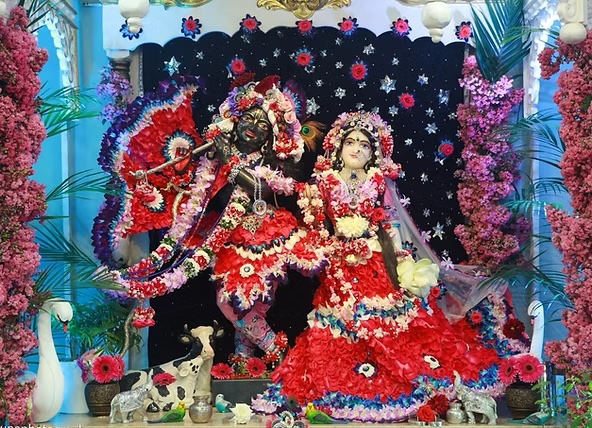Hare Krishna. I’m grateful to be here with all of you today. Thank you for joining. If at any time you’re not able to hear me, please let me know.
Today, we are assembled on the occasion of the festival commemorating the sacred union of Sita and Ram. I will talk about this from three different perspectives, broadly. I’ll talk about the philosophical perspective in terms of what is actually happening. Then, we’ll talk about the historical perspective of how the event happened. And finally, I’ll talk about the human perspective—what it means for us when we celebrate such festivals.
From the philosophical perspective, to give a broader context of what is happening, there are broadly two extremes in approaching God. One is to consider God to be so great, so sacred, and so sublime that God becomes almost inaccessible, in the sense of being too otherworldly. The other extreme is… so, when we talk about the conception of God, one extreme would be too divine to be humanly acceptable. Here, we focus on the principle of divinity so much that the personhood of divinity is lost.
Sri Prabhupada gives the example of how, if we consider God to be great, the sky is great. The sky extends as far as our eyes can see, and just beholding the sky can fill us with a sense of awe and insignificance about our own existence. But how do we really surrender to the sky? How do we develop a personal relationship with the sky? It doesn’t happen very easily.
So that’s why, if we perceive God as too divine, then God becomes reduced in the very attempt to make Him so great. In emphasizing God’s greatness, we end up making God inaccessible and unrelatable.
The other extreme is to make Him too human to be divine. That means, if we focus only on the personhood of God and start thinking of God as just another person like us—just a little more powerful than us or maybe much more powerful—then that’s all there is to it.
Here, there is the danger of sahajiyaism. When we make God too divine, there is the danger of impersonalism. Even if we don’t accept the impersonal philosophy, we may end up having a very formal, almost impersonal relationship with God. On the other extreme, we can have sahajiyaism, wherein we connect with God but take Him very cheaply. That is a challenge.
So, we want to avoid both these challenges. In between lies the understanding where there is both God’s greatness—His Aishwarya—and His sweetness—His Madhurya.
Now, generally, the words Aishwarya and Madhurya are used frequently in relationship with Krishna, but they apply to all manifestations of divinity. Especially in the Bhagavata Amrita, the Sanatana Goswami explains that there is a greater manifestation of intimacy in Ram and Narasimha avatars as compared to other manifestations of divinity.
And thus, there is the greatness that arises from remembering that God is not just a person—He is a principle. And the sweetness arises from remembering that He is a person.
When the Lord descends to this world, there is a higher spiritual level of reality and there is our material level of reality. Intermittently throughout history, the Lord descends to this world. He stays here for some time, and then He departs. His descent is the avatar.
When the Lord descends as an avatar, what happens is that His descent is, at one level, like a trailer. A trailer of a movie is meant to trigger desire within people. If this trailer is so good, we want to watch the full movie. In the trailer, the Lord reveals a beautiful, exquisite, mesmerizing form of His pastimes. Through that panoramic revelation, He inspires our heart to move towards it.
But that is not all the avatar, especially the avatar and leela, does. The second is that it sets up a dream. The Lord doesn’t just give us a glimpse, but He also tells us: “Okay, this is what you can do to come to Me.” Just like when a movie trailer comes, after it, there is information that says when and where it will be released—on an OTT platform, in theaters, in a country, or so on. Similarly, the Lord gives us much more than just information. The Lord outlines a path by which we can come toward Him.
This trailer is what is described in Bhagavad Gita 4.7 and 4.8. Krishna says that “I come and I perform; I establish dharma.” Those who become attracted to His pastimes can actually attain Him.
In one sense, the trailer is displayed for everyone. But, say, a trailer is released to the public—that doesn’t necessarily mean everybody is going to go and watch the movie. Relatively, a very small number of people will go and watch the movie. So, the trailer is for the select. Not everybody who hears about Krishna will necessarily want to become His devotee.
Still, Krishna gives that path to everyone.
Now, when the Lord descends to this world, one of the fascinating aspects of the avatar is the mysterious nature of the very concept of His descent. The Lord is infinite, and an infinite Lord comes into the finite domain. How does He manifest?
The Lord is unlimited, and this world is limited. The mystery of the avatar lies in how the unlimited manifests in the limited. How can the Lord, who transcends space and time—indeed, the Lord from whom space and time come, the Lord within whom space and time exist—how does that Lord, who is the container of space and time, who is the source of space and time, the source of everything, and the sustainer of everything… how does that Lord become contained within space and time, appearing to be just like another human being?
That is the mystery of the avatar, and that’s how the Lord descends to fill our hearts with wonder and spiritual desire.
Among the various pastimes that He performs, there are some pastimes that are clearly divine, and there are some pastimes that are almost like human ones. He is always divine in the sense that He is the Supreme Lord, but He sometimes acts divine and sometimes acts human.
That means when Ram is chasing after Maricha in the form of a deer, at that time, He doesn’t act divine. If He were divine everywhere—in hands and legs—He could just extend His arm unlimitedly and catch the deer. But He does not do that. At that time, He is just a human.
However, there are moments when He acts divine. For example, when the ocean does not give Him a way, even after He acts as a human and performs austerities diligently, the Lord becomes angry. He starts glancing with anger at the sea, and the vast ocean begins churning and burning because of the heat. The Lord of the ocean immediately rushes out, seeking Lord Ram’s mercy.
So, there are times when the Lord acts human, and there are times when the Lord acts divine. There are pastimes in which, at different phases, He manifests both these abilities—both these sides. For instance, He acts human while chasing Maricha, as I mentioned. But then, He acts divine when He scorches the ocean.
Let’s now see how this human-divine dynamic within the avatar manifests in the pastime we are going to discuss: His first encounter with Sita, His subsequent winning of her hand, and His marriage to her.
In the manifest leela of the Lord, He appears to Dashrath as the son of Dashrath in Ayodhya. He lives in Ayodhya until He is about 14 years old. He hasn’t even reached the age of 16—16 or 18 generally being considered the age of adulthood. Nowadays, the legal age of adulthood is 18.
This is one of the reasons Dashrath gives when objecting to sending Ram to fight demons. Dashrath argues that Ram is too young and cannot fight demons. He offers to accompany Ram with his army if demons need to be fought. But Vishwamitra insists that he wants Ram, and since Lakshman has never been separated from Ram, Lakshman also goes along.
So, Ram and Lakshman leave Ayodhya and, for a brief while, they stay in the forest at Vishwamitra’s ashram. It is here that we first witness Ram’s phenomenal promise. Before this, Vishwamitra blesses them with celestial weapons. He teaches them the mantras by which they can invoke the higher powers within the universe and be blessed with weapons from those higher beings.
Thus equipped, Ram exhibits extraordinary valor in protecting Vishwamitra’s sacrificial arena. The sacrificial arena is primarily meant to bring auspiciousness. It is said that when we perform Sankirtan Yajna, it brings auspiciousness into the world. Similarly, sages perform sacrifices to bring auspiciousness, but demons try to prevent such auspiciousness. That is why they desecrate and even attempt to devastate the sacrifices.
And here, Lord Ram takes the responsibility of protecting the sacrifice.
And thus, he manifests how he is the protector of dharma. Vishwamitra is pleased, as he has a particular plan for him.
Until this point in his childhood, Ram has shown extraordinary virtue and skills, but he has never had such phenomenal feats of promise. Krishna, right from his childhood in Vrindavan, faced demons attacking him, which he playfully dismissed. In the case of Ram, there is no description of demons coming to Ayodhya and attacking. Ayodhya itself, by name, indicates a place that was unconquerable (Ayodhya). It was a formidable and powerful kingdom. Therefore, there were no such dangers, and Ram did not face any threats as a child.
But now, through a series of heroic activities, one after another, Lord Ram displays his valor. He destroys those demons who have been terrorizing the earth and desecrating the hermitages of the sages. At this point, Vishwamitra says, “I have something else for you to do.”
Now, princesses often live in luxury, being constantly served by others. Yet, they know that their lives are also meant to be lives of service. Sometimes, we may find ourselves in roles where we receive service. And yes, sometimes it may even be our service to receive service. But that should never make us forget that, at our core, we are still servitors.
Sometimes, we may need to perform a particular service in a specific way. And to do that service, others may offer us some service in turn. But we remain servants. The princesses, accustomed to being served, suddenly find themselves plunged into a life of austerity. There are no servants accompanying them.
Vishwamitra insists that he only wants Ram and Lakshman for this mission. In truth, he wants only Ram, but since Ram and Lakshman are inseparable, they go together. There are no guards, no servants accompanying them. They are all alone. Not only do they take care of themselves, but after the sacrificial ceremony is completed and everyone celebrates and rests, Ram and Lakshman wake up the next morning, offer their respects to Vishwamitra, and ask him, “What service can we do for you today?”
Vishwamitra replies, “The King of Janaka is performing a great sacrifice. I would like you to come with me there.”
Service can sometimes mean to give service, and at other times, to receive service. But even receiving service can contribute to a greater service. Here, Ram and Lakshman are not taking on the roles of princes but of servitors of the sages. As servitors of the sages, they agree to the mission.
Vishwamitra then leads them. They cross the Son River, come to the Ganga River, and follow the Ganga until they finally reach Mithila.
Mithila purajanmoha kara, videhi maana saranjakarama.
In the Ramayana, it is described how, when they arrive in Mithila, the emperor is captivated. Vishwamitra is a well-known sage, a celebrity in that region.
It is fascinating to note that although Ram and Lakshman are princes and, by worldly standards, might be considered far more illustrious and famous than sages, the culture at that time revered the sages. We might imagine a wealthy, influential person being constantly in the media, with their children also gaining fame by association. On the other hand, sages, unless they were actively involved in societal affairs, might not have been as well-known.
Yet here, Vishwamitra is a celebrity. The culture of the time placed brahmanas and sages as role models. In our lives, there are different kinds of role models. Some inspire us, while others provide us with a pathway. Inspiration comes from seeing something great and respecting it. But not everyone who inspires us is someone we can immediately follow.
Like we cannot always follow the great austerities of Vrindavan, or at least not at the same level as the sages or great spiritual personalities. We need role models who are similar to us—people who have careers, families, and social lives, but who are still very serious about their spiritual lives.
In those times, sages were like celebrities high up in the sky. Not everyone could become like them, but they were respected immensely. Unlike today, where social media makes everyone’s face and identity easily recognizable, that was not the case back then. Painters were also not very common. Unless someone had personally seen another, it was difficult to recognize them.
This is how, during the Pandavas’ Ajnaatvas (period of incognito exile) in the palace of Virata, no one could recognize them. Normally, we think that if someone is a celebrity, their face is known to everyone, making them instantly recognizable. But that wasn’t true in those times.
When Ram and Lakshman arrived in Mithila with Vishwamitra, the citizens were curious and began speculating. Visitors entering the city caught their attention. The people lined up, peering at the young men accompanying Vishwamitra.
Vishwamitra had not brought many of his disciples or followers; he came alone with Ram and Lakshman. The princes offered their respects to Vishwamitra, and the citizens began whispering among themselves, wondering who these two were.
“They look like princes, but they aren’t dressed in royal opulence. Yet, they look so illustrious. Could they be the princes of Ayodhya?”
When the news spread that the great sage Vishwamitra had arrived, King Janaka personally came to greet him. He fell at Vishwamitra’s feet, offered his respects, and invited him into his palace. After washing the sage’s feet, he allowed him to rest, served him a sumptuous feast, and ensured he was refreshed.
Once Vishwamitra had rested and eaten, King Janaka approached him with great reverence.
“O blessed sage, it is an honor that you have come to my kingdom. Please instruct me—how may I serve you? What is your desire?”
He then asked, “Who are these two powerful and majestic young princes?”
Janaka was already impressed by their physical strength and personal beauty. Vishwamitra replied, “These are the princes of Ayodhya. They have come to see the special bow of Lord Shiva that you have.”
Just hearing this filled King Janaka’s heart with excitement and anticipation. Could they string the mighty bow? Could one of them become his son-in-law?
Janaka looked at Ram with fresh eyes. He had heard of Dasharath’s son Ram before—Dasharath was a close friend of his—but now seeing Ram grown into such a majestic and regal figure, Janaka was filled with admiration.
With great joy, Janaka said, “Rest today, and tomorrow, I will fulfill all your desires. I will take you to see the bow of Lord Shiva and honor your request.”
Now, to provide some context, Janaka is a dynastic title. Just as we refer to a pharaoh in Egypt or an emperor in Rome, the king of Mithila was referred to as Janaka. This title was passed down through the dynasty. The particular Janaka in this context was named Siradhvaja.
Siradhvaja had a brother named Kusadhvaja, and he had two daughters: Yonija and Ayonija. Yonija means “one who is born from a womb,” i.e., born naturally. Ayonija refers to someone not born in the usual way. Sita, the divine princess, was Ayonija.
Sita’s birth was miraculous. While Siradhvaja was performing a royal sacrifice, the plow being used in the ritual struck something hard beneath the earth. Stopping the ritual, he looked down and saw a beautiful baby girl emerging from the earth. This baby was Sita.
Sita’s name comes from a Sanskrit term related to her miraculous origin. Sita means “furrow,” as she was discovered during the plowing ritual. It is also derived from the Sanskrit phrase Sheela Jata, where Sheela means “stone” or the hard earth from which she emerged.
The origins of the name Sita have many interpretations, but the central idea is that she was not born in the usual way. She was Ayonija, not born from a womb, but discovered during King Siradhvaja’s sacred plowing ritual. His other daughter, Urmila, was born naturally through his wife.
Now, in this dynasty, there was a great legacy inherited from the gods—a divine artifact known as the Shiva Chapa. Chapa means “bow.” This bow carried a fascinating history connected to Lord Shiva.
Among the devatas (celestial beings), Lord Shiva is quite an outlier. Unlike Indra and other devatas who live in regal majesty and partake in elaborate ceremonies, Shiva lives a more austere and unconventional life on Mount Kailash. He is indifferent to the social and ceremonial norms that other devatas observe. This unconventional nature of Shiva is one reason why Daksha Prajapati disapproved of his daughter Sati marrying Shiva.
At one point, the devatas, thinking Shiva was not fully one of them, neglected to offer him a portion of the sacrificial offerings during a yajna (sacrifice). Lord Shiva was deeply displeased by this offense, not merely for personal reasons, but because it indicated the devatas’ pride and their disregard for the universal order. Such arrogance, Shiva knew, could lead to their downfall.
In his anger, Lord Shiva appeared before the devatas wielding a formidable bow. He chastised them, saying, “You impudent devatas! Do you understand the offense you have committed? With this bow, I will destroy all of you. If any among you has the courage, stand and fight!”
The devatas, terrified and humbled by Lord Shiva’s fury, realized they could neither confront him nor escape his wrath. They fell at his feet and begged for forgiveness. True to his nature as Ashutosh (the easily pleased), Lord Shiva was quickly pacified by their remorse.
It’s interesting to note that while Shiva is often referred to as Yogiraj (the great yogi), embodying qualities like equanimity and detachment, his personality also reflects volatility. He can get angry very quickly but is also easily pacified. However, this apparent contradiction is part of how Lord Shiva serves the Supreme Lord—acting as both a protector and a purifier in the universal order.
After forgiving the devatas, Shiva, in his satisfaction, gifted them his personal bow as a symbol of his mercy. Later, this bow came into the possession of King Devarata, an ancestor in the dynasty of Janaka. Devarata had performed great sacrifices to please the gods, and as a result, he was entrusted with the Shiva Chapa.
This divine bow was not an ordinary weapon. Its size, power, and celestial origin made it practically unusable by any human being. It became a symbol of divine legacy, kept not for practical use but as a sacred relic representing immense power.
When King Janaka came into possession of this bow, he had already been told by Narada Muni about the divine identity of Sita. Narada informed him, “The daughter who has appeared to you mystically is the eternal consort of Lord Vishnu. In the future, she will marry Vishnu.”
Taking this to heart, Janaka decided that Sita’s hand in marriage would only be granted to someone who could fulfill an extraordinary task—a feat that only Lord Vishnu could accomplish. The challenge he set was to lift and string the Shiva Chapa. This ensured that only the Supreme Lord, in his human form as Lord Ram, would be able to claim Sita as his consort.
This extraordinary condition had been set. So in this way, it’s almost like, while the Lord is performing His pastime, the stage is being set for Him to manifest His divinity. Now, in some later retellings of the Ramayan, there are descriptions of Ram doing some wonderful and even miraculous activities in His childhood, but in the main retellings of the Ramayan, that is not so much the case. Ram’s killing of Tataka and Subahu is extraordinary. At the same time, that’s a feat of heroism. That’s not necessarily a feat that establishes His divinity. There could be kings who were extremely valorous and skilled, and they could achieve extraordinary things. Arjuna was a spectacular warrior. Arjuna had defeated all the devatas combined together, and that made him extraordinary, but that didn’t still mean that he was divine. So this is one of the first incidents in which Lord Ram’s divinity will become manifest, and as we move forward, there are more such incidents.
Janak Maharaj, sorry, King Janaka tells the sage, as well as especially the princess. He knows that the sage already knows, but still, they are going to see something wonderful. If we have some guests coming, we have a grand temple, and when we show them the temple, we like to give them some background. We explain, “This temple was built in this way, it has this kind of stone, this kind of marble.” You want to give them the context, explain the glory of what is going to be seen. Similarly, Janaka is giving this context, and then they come into a part of the palace where the Shiva Chapa is kept. It’s bedecked with jewels, and several hundred people are required just to move that trunk itself into visibility for everyone to see. Then that trunk is opened, and both the princes, Ram and Lakshman, gasp with admiration. As I told before, it is a massive bow, bedecked with gems and bells around it. This is more of a ceremonial bow rather than a practical bow for fighting.
Holding it, Ram turns toward Vishwamitra with inquiry on His face, and a smile gently spreads across Vishwamitra’s face. He nods; he knows what Ram is going to do, and he is eager for Ram to display His divinity. He knows that he has a role to play in Ram’s pastimes, and this is going to be the most significant thing he will do. Vishwamitra has the role of being a king who renounces his kingdom to become a sage, but now, as a sage, he has been given the role to reveal the divinity of one who has manifested in royalty.
So first, this divinity is displayed, and now, again, it’s heroism, but heroism of such a superlative nature that it amounts to almost divinity. Ram then comes forward and nonchalantly places His hand on the bow. Before Him, many of the greatest kings of the earth had come, and they had to lift this bow. They hadn’t even been able to shrink it out of the casket, let alone lift it, much less bend it so they could string it. Each of these acts required great strength—first lifting, then moving it, and even after lifting it, they had to bend the bow. When you string a bow, the string has to be tight enough, so the tension in the string allows the arrow to fly properly. The bow has to be firm enough so that it is not easy to bend, and once bent, it needs a substantial amount of tension.
Most of the kings hadn’t been able to lift the bow, let alone bend it or string it. But Lord Ram just nonchalantly picked up the bow, bent it silently, and everyone watched in anticipation, wondering what He would do. Lord Ram kept one end of the bow on the ground. It was a huge bow, and as He bent the bow downward, He was going to string it, but the force with which He bent the bow caused it to break. When it broke, the sound was like the crash of thunder falling on the palace. It felt as if the whole earth was shaking, as if in an earthquake. Everyone who was beholding it was stunned and became temporarily senseless and speechless. Just this was what had happened. Their sense of peace was diminished, and then erupted celebrations and glorifications. They all started cheering and praising the spectacular feat of Lord Ram. The celestials assembled overhead, cheering for Lord Ram and showering flowers upon Him.
All this had been happening in a part of the palace, and there was a terrace nearby. In that upper floor, Sita was watching. She was very devout. From her childhood, she had an innate attraction toward Lord Vishnu and had prayed that, “May Lord Vishnu be my husband.” Until then, many great kings had come to seek her hand, but none of them had charmed her heart. She found them too arrogant, too boastful. But when she saw Ram move forward toward the bow, her heart suddenly filled with excitement, joy, and affection. When Ram broke the bow, she became so elated that she was almost bursting with happiness. But due to chastity and feminine shyness, she restrained her emotions and waited.
Then Janak Maharaj looked at her, took a step forward, and she came down the stairway. At the time when Lord Ram beheld her, and both of them beheld each other, their hearts filled with love for each other. Sita came forward and offered the garland to Lord Ram. This matrimonial garland was offered by Sita. Now, this itself was not the wedding ceremony; it was her accepting or congratulating the person who had won the contest, the person who had stood up to match the target, the criteria that had been set.
And then Janak Maharaj turned to Vishwamitra and said, “You will see Ram and Sita’s wedding to be held as soon as possible.” He said, “For such a wedding to happen, naturally Ram’s parents must be informed, they must give their consent, and they need to come immediately. Send the messengers immediately.” He sent the messengers—though not just messengers, he sent his ministers. They rushed from Mithila to Ayodhya, and it took them three days to reach there. When they arrived, there was anxiety; Dashrath was concerned, “My son has gone out, and I don’t know what is happening. Where is he? Has the battle with the asuras been going on for such a long time?” But then, after he was informed, he calmed. When he heard that messengers from Mithila had come, he wondered, “Why are they here?” Though there was some anxiety in his heart, he welcomed them with a benign expression. Janak was his great friend, and when he heard the news, it brought him joy. Not only had Ram been saved, not only had he been victorious in killing the demons and fulfilling Vishwamitra’s desires, but beyond that, he had broken the bow—the Shiva bow—that no one could move, and he had won the hand of Sita. In great joy, Dashrath immediately planned to go to Janak Maharaj’s kingdom. Janak Maharaj welcomed him, and Dashrath came with his entire family.
Then Janak Maharaj said, “Let there be a bond between our families that runs across many individuals.” Lakshmana had also come there, so Janak said, “Let Lakshmana marry Urmila.” “Thus,” he continued, “both my daughters will be married to your sons.” He also said, “Ushant Vajay has two daughters; let them be present as well.” In this way, four marriages were performed. Now, Janak had his royal priest, Shatananda, and Vishwamitra, and Dashrath had his priest, Vashistha. The two priests conferred and decided that the next day itself was an auspicious day for the marriage ceremony. Normally, these ceremonies take weeks or months of planning, especially if royalty is involved, and kings from other lands need to be invited, with many arrangements to be made. But Janak Maharaj had been so eager for the wedding of Sita that he had already made arrangements. He had already set up the pandal and was waiting for a suitor who met the criteria. A standing invitation had been issued: when news came that the bow had been broken, the wedding would happen soon.
Many kings had already gathered out of respect for Janak Maharaj and their eagerness to witness the majestic event—the wedding of Janak’s daughter, Sita, with the person who had broken that phenomenal bow. Under the supervision of Vashistha Muni and in the presence of Vishwamitra, the wedding ceremony took place. Then Janak came and brought the princes, who were already sitting around the fire, and he placed his daughter next to Ram. Janak placed Sita’s hand in Ram’s hand, and together they offered the offerings to the fire. They circumambulated the fire and sought the blessings of the elders. This way, after the wedding of Ram and Sita was performed, the weddings of his brothers were also performed with the sisters and cousins of Sita. All four young couples would be married and return together to Ayodhya. Of course, while they were returning to Ayodhya, they met Parashuram.
Parashuram had become quite proud of his Brahminical promise, and he realized that now his time was over, except for his official discount. So, this event of the wedding, in one sense, is the trajectory through which Ram demonstrates His heroism and, indeed, His divinity. While His divinity is manifested by His breaking of the Shiva bow, it becomes even more evident when Parashuram tries to attack Him. Lord Ram doesn’t want to attack Parashuram because he is a Brahmin, but through His mystic powers, He disarms Parashuram. Parashuram is unable to shoot his arrows, and he understands that Ram is the Supreme Lord.
So, this trajectory is extraordinarily manifested, with divinity coming forth in the union with His eternal consort, Sita. Now, what can we learn from this? Probably three distinct things. First, I started by talking about how the Lord may not be easily relatable to us if we focus only on the principle.
There are certain events of great significance in our lives. For example, when we get married, it is a time of great significance—one of the most consequential decisions we will make. Traditionally, in India, when a couple would get married, there would always be comparisons such as, “Oh, the couple looks like Sita and Ram,” or “They look like Parvati and Shiva,” or “Lakshmi and Narayan.” The idea is that two things are being reflected here: one is that the Lord, when He descends and goes through the ceremonies of life—the typical rites of passage—demonstrates how we seem to go through them. The Lord gives us sacred memories through these rituals.
When we say, “The couple looks like Sita and Ram,” this does not mean that our relationship should mirror theirs in every way. Ideally, by being reminded of that divine love, we are encouraged to recognize that, although love in this world is temporary, it can point toward the eternal. The temporary can be an ear toward the eternal. As Prabhupada said, one of the purposes of the scriptures is to bring all people closer to each other and closer to Krishna, the supreme entity. So when we form a bond here on earth, we should remember how the Lord descended and formed a bond. It is not that we look at the Lord’s wedding and simply remember our own wedding day, or participate in the ceremony for our own enjoyment. We remember that this relationship is not just for us to come together and enjoy, but to come closer to the Lord through this relationship. We come together so that we can strengthen our eternal relationship with Him. This is the eternal enjoyment.
When the eternal Lord manifests as earthly love, particularly when He and His consort get married, it is a spiritual stimulus for us to enhance our remembrance of the Lord. The Lord’s wedding, or Sita Kalyanam, can serve as a reminder for us—whether it is our own wedding or someone else’s. At that time, instead of just focusing on the two people involved, we can see it as a spiritual reminder. Krishna tells us in the Bhagavad Gita (10.41) that everything in this world can become a stimulus for us to remember Him.
The second point is that when the Lord descends into this world, as I mentioned earlier, it’s like a trailer. The beauty, sweetness, potency, and majesty of the Lord, by which He wins the heart of Sita, are not just about the criteria He meets to win her hand. It is by His personality, His nature, and His sweet, loving disposition that He wins Sita’s heart. So much so that Sita insists on going with Ram, and she is excited when He is excited. Even though He doesn’t have to go, she insists on accompanying Him. This shows how the Lord exhibits extraordinary virtues.
Then, some of His extraordinary virtues are manifested. His promise, however, does not lead Him to pride. Even when He wins the hand of Sita, He does so under the guidance of His elders. Vishwamitra asked Him to break the bow, and He does it. But even then, He doesn’t rush into marriage; He waits for His parents’ approval. It is only when His father gives His blessing that He proceeds with the marriage. So, the power that Lord Ram has is accompanied by respect. His individual power doesn’t go to His head; He maintains His respect for the elders.
The final point is that through the loving union between Ram and Sita, and in this particular instance, the eternal love between them is manifested in this world. They are the ultimate “power couple”—Sita-Ram, Lakshmi-Narayan, Radha-Krishna. All the power in this world comes from them. They are the divine couple, but when they manifest and develop their relationship, it’s not just a demonstration of the sweetness of divine love; it’s also a model for how relationships in this world should be formed—with humility, respect, and a gradual opening of the heart.
Lord Ram is Maryada Purushottam—He always respects the boundaries (Maryada), follows dharma, and maintains the proper etiquette. His life is a model of respect and Maryada.
Finally, Lord Ram unites with Sita. This union is an example of true love and devotion. Ram’s heart is conquered by Sita to such an extent that He vows never to marry again and remains in pati-vrata (faithful to one wife). Though it was common for kings to have many queens, Sita completely conquers His heart. Their bond becomes sealed, and what is eternal is manifested and fulfilled in this world.
For us, the relationship between us and Krishna is different from relationships in the material world. But the principles of relationship-building are the same. In any relationship, there must be virtue and valor on both sides for a glorious relationship to form. Sita and Ram each had their set of virtues, and from these virtues, a beautiful relationship was born. What was eternal in them was manifested on earth.
Just as Ram and Sita had their virtues, their example inspires us to develop similar virtues so that we can form deep, fulfilling relationships in this world. By doing so, we move toward our eternal relationship with the Lord, which is more hidden in this world but will be revealed and fulfilled in its fullest in the Lord’s eternal love.
To summarize what we discussed today:
- Philosophical Perspective of the Lord: Our conception of the Lord should not be overly focused on His divinity to the point where He becomes depersonalized, nor should it be reduced to just human characteristics. There needs to be a balance of appreciating both His greatness (Aishwarya) and sweetness (Madhuriya). The Lord’s avatar lila is like a trailer for those who want to follow Him, guiding them toward higher pastimes.
- Lord Ram’s Glory: Through incidents like killing demons, breaking the bow, and confronting Parashuram’s pride, Lord Ram’s heroism and divinity are revealed. His glory is manifested not only through human actions but through the divine powers He possesses. In defeating Parashuram, His divinity is made evident.
- Lessons for Us: We can see the Lord’s wedding ceremony as a reminder to cultivate our remembrance of Him. Any wedding we are a part of can serve as a spiritual stimulus, encouraging us to recall the divine wedding of Ram and Sita. The relationship between Ram and Sita was built on virtues, and their example teaches us how to form relationships with respect, valor, and humility. Ram’s power did not make Him arrogant; He remained humble and respectful of His elders. Similarly, relationships in this world should be based not just on physical attraction but on virtues. The ultimate purpose of any relationship is to come closer to Krishna and to each other.
In conclusion, the way Ram and Sita manifested their eternal relationship in this world provides us with inspiration for developing fulfilling relationships in our lives. By cultivating virtues and devotion, we can draw closer to Krishna and experience deeper, more meaningful connections with those around us.
Thank you very much.
The post Approximate transcript – Rama-Sita wedding How their eternal love can guide our earthly love appeared first on The Spiritual Scientist.



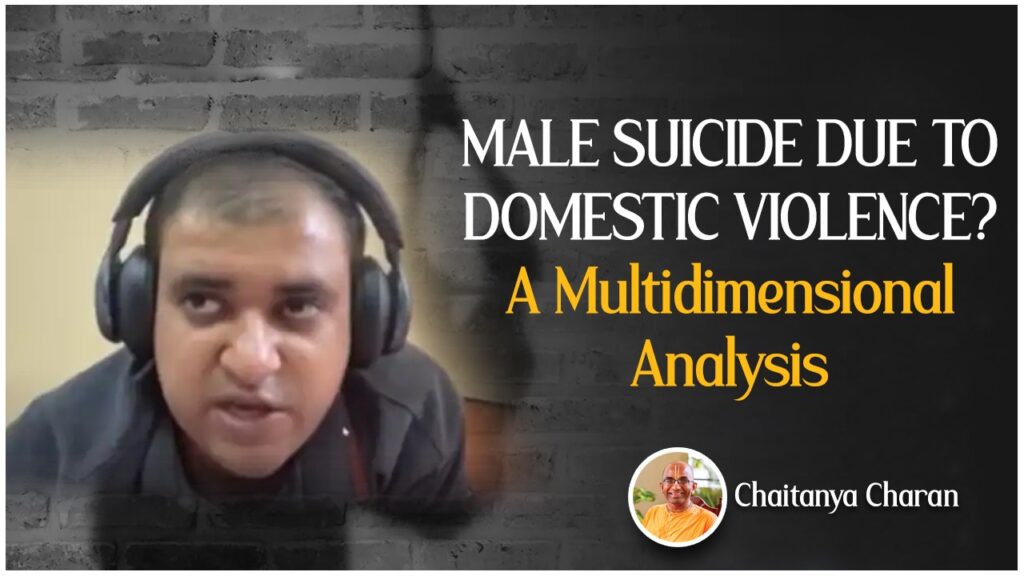
 Gita Jayanti is the day on which Lord Krishna spoke the Bhagavad-gita to Arjuna.The Gita is also known as the Gitopanisad and is considered one of the Upanishads. The title Bhagavad-gita is sometimes translated as “The Song of God.” Gita means “song.” God, Krishna, is so sublime that whatever He speaks is music and poetry. The word bhagavan has been analyzed by Vedic authorities. Bhaga means “opulence” and is related to the word bhagya: “good fortune.” And van means “one who possesses.” So bhagavan means “He who possesses all opulence in full.”
Gita Jayanti is the day on which Lord Krishna spoke the Bhagavad-gita to Arjuna.The Gita is also known as the Gitopanisad and is considered one of the Upanishads. The title Bhagavad-gita is sometimes translated as “The Song of God.” Gita means “song.” God, Krishna, is so sublime that whatever He speaks is music and poetry. The word bhagavan has been analyzed by Vedic authorities. Bhaga means “opulence” and is related to the word bhagya: “good fortune.” And van means “one who possesses.” So bhagavan means “He who possesses all opulence in full.”



 Today is Odana-sasti, the date on which Lord Jagannatha is given a winter shawl. One year when Lord Chaitanya and His associates celebrated this festival in Puri, Pundarika Vidyanidhi, who is Vrsabhanu Maharaja, Srimati Radharani’s father in krsna-lila, received some special mercy. His experience is instructive for us all.
Today is Odana-sasti, the date on which Lord Jagannatha is given a winter shawl. One year when Lord Chaitanya and His associates celebrated this festival in Puri, Pundarika Vidyanidhi, who is Vrsabhanu Maharaja, Srimati Radharani’s father in krsna-lila, received some special mercy. His experience is instructive for us all.








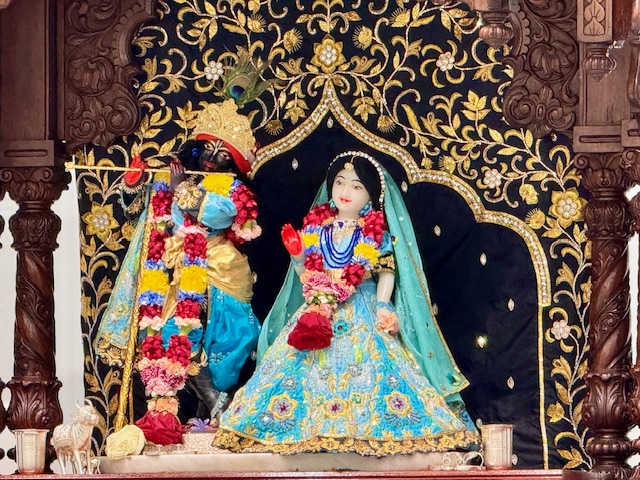
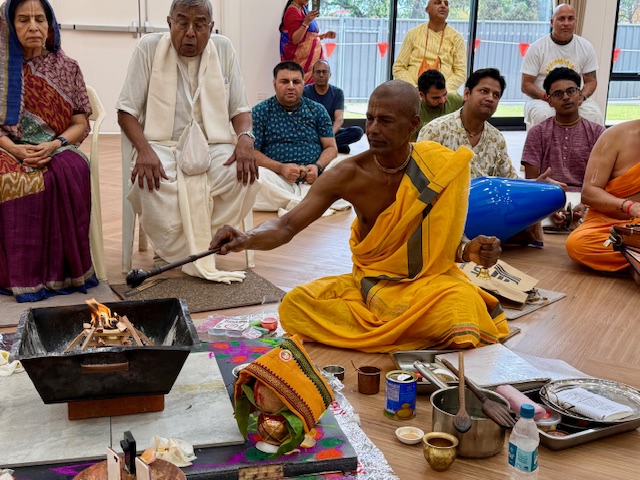
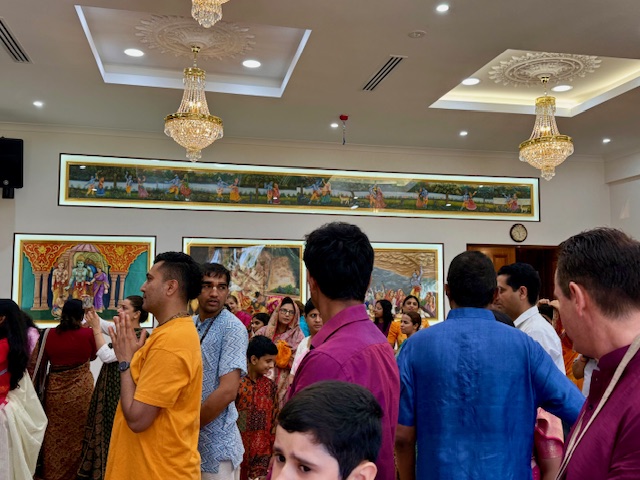
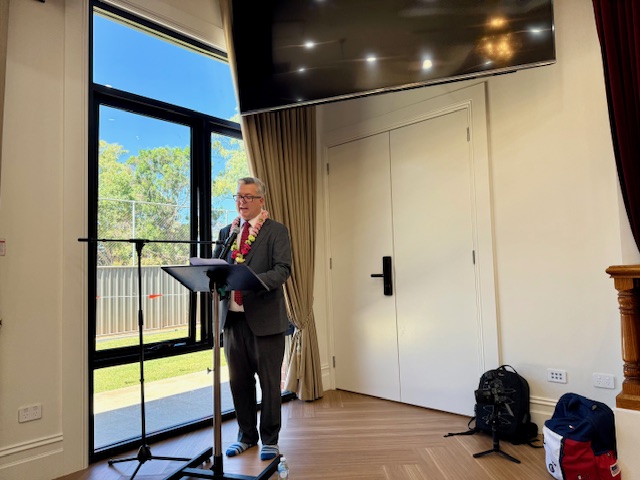
 By Jaganmohini dd
By Jaganmohini dd By Vijaya Das
By Vijaya Das I will never forget the moment when I heard that George Harrison had passed away, one week after Thanksgiving in 2001. My strong feelings of separation surprised me—and made me think how important and dear George must have been to Srila Prabhupada and Sri Krishna. And I remembered my own little experience with him.
I will never forget the moment when I heard that George Harrison had passed away, one week after Thanksgiving in 2001. My strong feelings of separation surprised me—and made me think how important and dear George must have been to Srila Prabhupada and Sri Krishna. And I remembered my own little experience with him.



